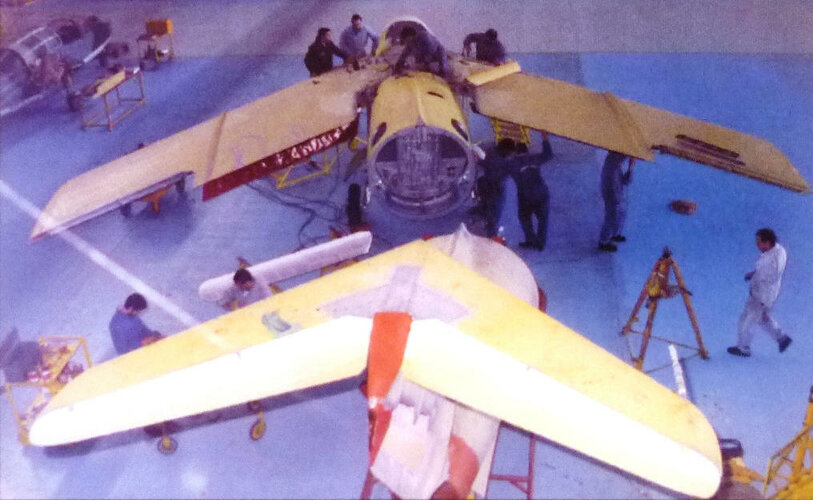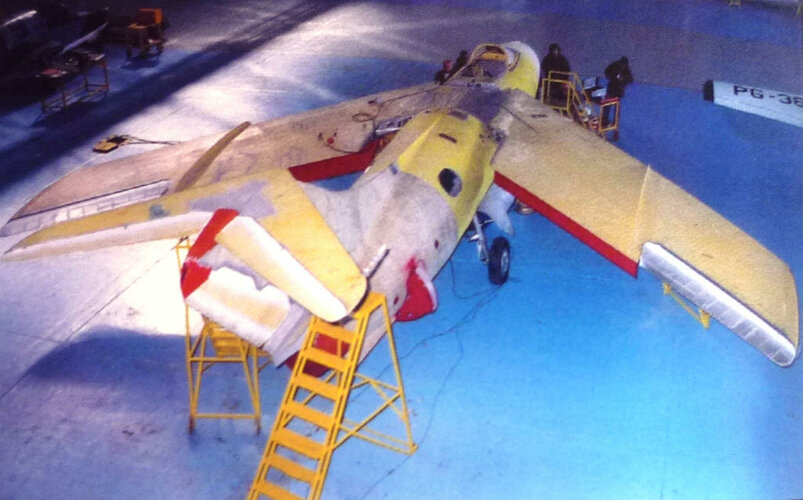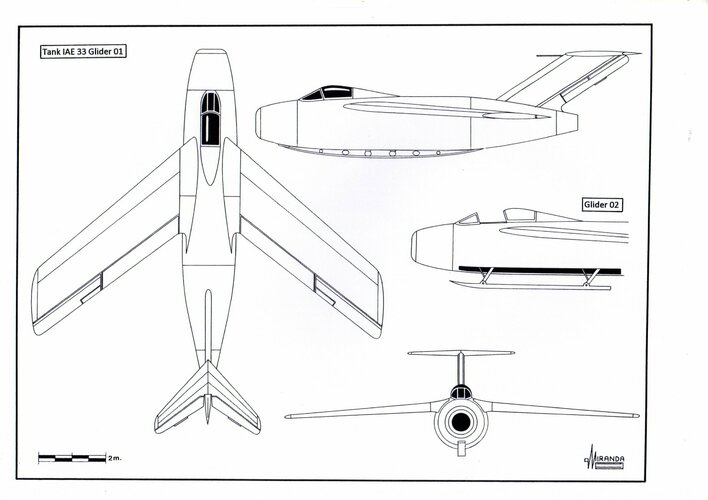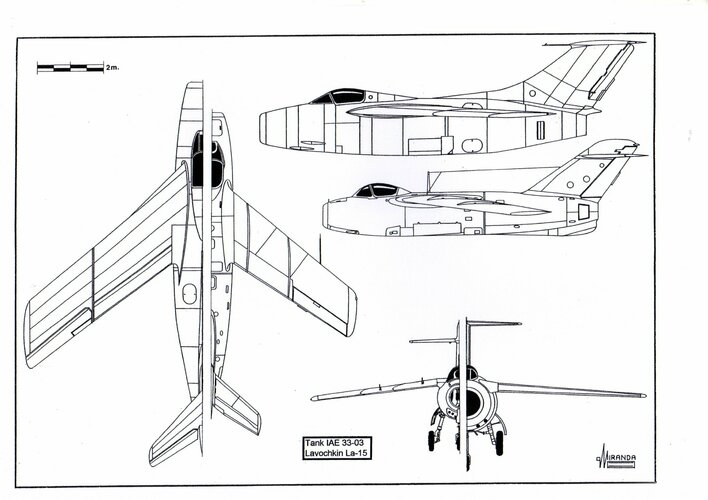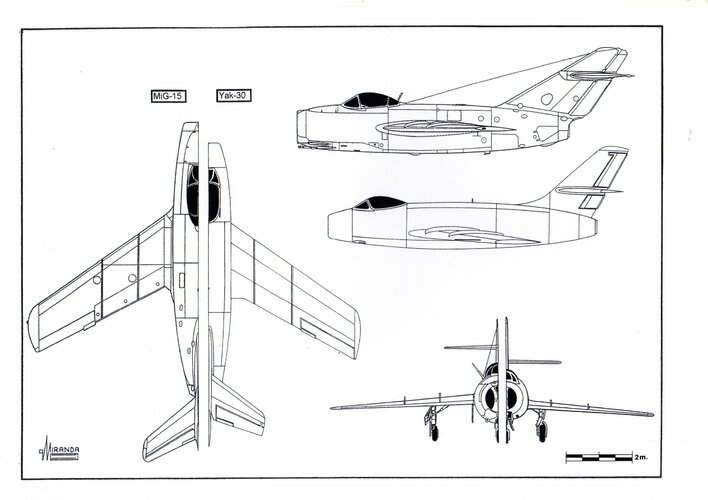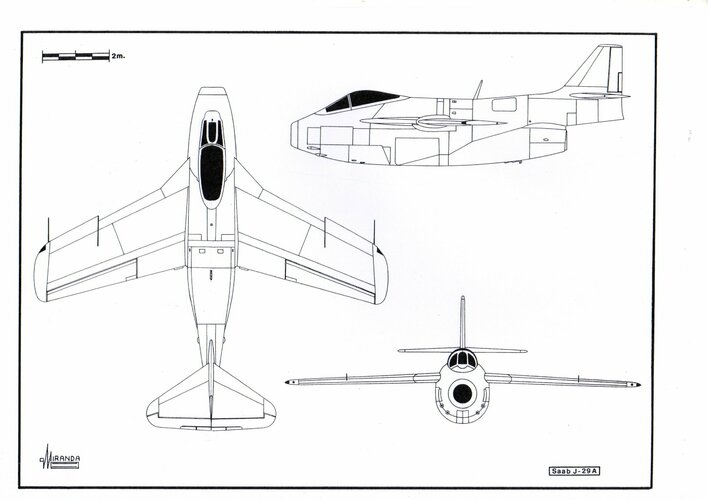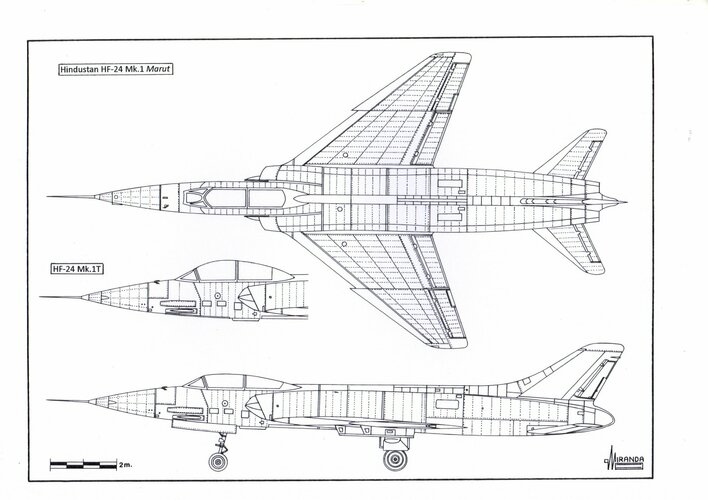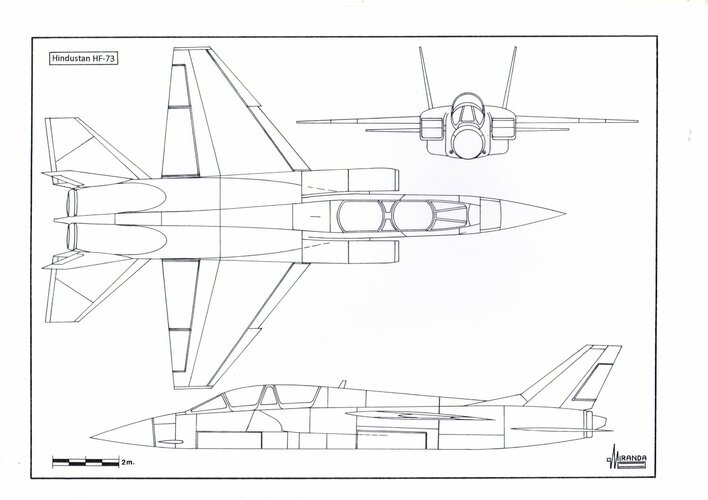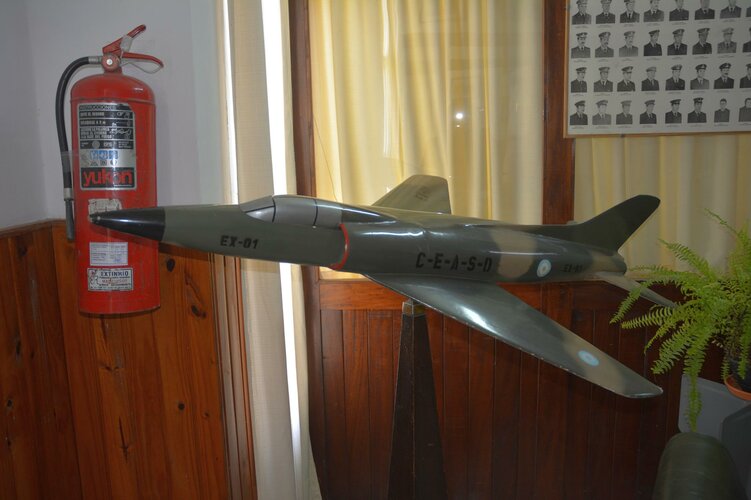Tank/Hindustan HF-24 Marut
In the years following Second World War many countries were forced to modernize their Air Force by acquiring the new technology of the turbojet to the winning powers. Those who chose to use the export versions of the Gloster
Meteor regretted their decision when the performances of the new Soviet fighters were known. Dutch and Egyptians, interested in the work carried out by Kurt Tank's team in Argentina, began negotiations for the acquisition of the IAE 43.
In 1955 the pursuit of self-reliance in aviation by the Indian Government led the Air Staff to issue a requirement calling for a home-made multi-role aircraft suitable for both high-altitude Mach 2.0 interception with a ceiling of 60,000 ft. and low-level ground attack, with a combat radius of 800 km. Furthermore, the specification demanded that the basic design be suitable for advanced trainer, all weather interceptor and shipboard versions.
The Air Staff overestimated the complexity of the task. The local aircraft builder Hindustan Aircraft Ltd. (HAL) had been building Vampire F.B. 52 and T.55 under license but its only autochthonous design experience was the HT-2 primary trainer.
The Indian Government decided to solve the problem by hiring 31 German specialists from Argentina. In response to the Indian invitation, Kurt Tank and his assistant Dipl.-Ing. Ludwig Mittelhuber arrived in Bangalore in August 1956 with the purpose of continuing the development of the IAE 43.
The HAL X-241 prototype was built early in 1959. It was a full scale wooden mock-up with 50 degrees rear swept wings, spanning 9 m, with a 6 per cent thickness/chord ratio and 25 sq. m area. Between April 1959 and March 1960, it was used as flyable air-launched two-seat glider, towed by a Douglas C-47, for low speed stability and oscillation trials. The X-241 lacked ejector seats and during its first flight revealed a worrying rate of descent of 3,800 ft. per minute and the stall warning was found to be too low. To visualize airflow effects, the left-wing panel had wool tufting and a fin mounted camera.
To improve the stall warning margin the wing surface was increased up to 28 sq. m, with the fitment of the saw tooth on the leading edge, extending the chord wing at the root by 10 per cent to improve handling. Other modifications consisted in the installation of an anti-spin parachute, a variable incidence tailplane, a boundary layer separator in the air-intakes and the extension of the nose leg oleo to facilitate take-off. The undercarriage retraction system, wheel-brakes, flaps and cheese-type air-brakes were operated with a pneumatic air bottle.
The improvements made by the extensive test program in the original design were used for the construction of the HF-24
Marut, an aerodynamically stable aircraft with excellent handling characteristics, pleasant to fly and with fine control responses for aerobatics. The aircraft was capable of supersonic flight to 1.5 Mach with manual controls in the event of hydraulic failure. The design of
Marut had been based on the availability of the 3,705 kp thrust Bristol
Orpheus B.Or. 12 reheat turbojet.
Unfortunately the British Government cancelled its financial support for the development of this engine and the
Marut had to be fitted with a pair of non-afterburning
Orpheus 703 (the engines that HAL was currently building under license for the Folland
Gnat Mk.I lightweight fighter) with 44 per cent less thrust than the B.Or 12. As a result, the
Marut offered only marginal improvement on the Hawker Hunter´s performance. On 17 June 1961, the prototype HF-001/BR 462 made its first flight powered by two Bristol
Orpheus 703, with 2,595 kp static thrust.
It differed externally from the glider in the new design of the air-intakes, with shock half-cones and upper lip extended to ensure smooth flow at high incidence, and in the adoption of wing slats.
The all-metal area-ruled semi-monocoque fuselage, with 15.87 m length, and the wet wing with tapering steel frame were very difficult to construct with the available means in HAL, but the great structural strength of the airframe compensated the effort. The aircraft required no artificial augmentation or auto-stabilization. It had Fairey hidraulic powered controls, with artificial feel and manual reversion in emergency, that were effective over the entire speed range. The pressurized cockpit included a Martin-Baker S.4C ejector seat. The landing gear retraction system was a Dowty-Rotol, with Dunlop wheels, Maxaret anti-braking device and steerable nosewheel. The structural test airframe was completed in November 1961 and the second prototype BR 463 flew eleven months later.
Between 1962 and 1967 both aircraft performed 1,800 test flights to iron teething troubles. During the armament trials carried out in 1964 it was verified that the vibrations caused while firing the four 30 mm Aden Mk.2 cannons produced structural damage.
The very low production rate and the extensive programme of tests delayed the entry into service of the
Marut Mk.1 fighter-bomber until April 1967. The IAF blanked off two upper cannons, operating only with the lower two, with 120 rounds per gun, in squadron service. The lack of appropriate power plant meant that the HF-24 could not fulfil its role as an interceptor and never came to install the radar provided in the original design.
Out of the 145
Maruts produced, 130 entered squadron service. No aircraft was lost in air combat during the December 1971 hostilities and with the destruction of about 100 enemy tanks and one Canadair
Sabre VI in dogfight, the HF-24 proved to be a stable weapons platform. Throughout the sixties, HAL directed a great search for more powerful engines, from various foreign sources, to exploit the latent potential of the
Marut airframe, evaluated by U.S. experts for a Mach 2 flight. However, the turbojets under consideration either could not provide a sufficient thrust, required too great structural redesign or became unavailable due to political reasons.
In 1961 the Russians were approached with the centrifugal-flow Klimov VK-7 turbojet, a very reliable engine with 3,525 kp thrust but with an excessive diameter, that could not be fitted to the existing HF-24 without major design changes. The Tumansky RD-9F was also considered; it was a small-diameter axial-flow turbojet with 3,750 kp (afterburning) used in the MiG-19 SF Mach 1.5 interceptor. Six engines were imported and bench-tested at Bangalore, while its installation in the HF-24 was found to be called for a little airframe modification. But the negotiations initiated in Moscow in July 1962 failed at the Soviet refusal to grant the manufacturing under license in India.
At the same time, the Egyptian government started the development of the Bradner E-300, an axial turbojet to power the Messerschmitt/Helwan HA-300 supersonic fighter. The new engine was tested in 1963, installed on an Antonov An-12, producing 4,800 kp dry and 6,700 kp with reheat. On 2 November 1964, the Indian Government proposed a collaboration agreement to develop the EL-300 version, with a smaller afterburner and 4,355 kp thrust, for the
Marut.
In July 1966, the pre-production aircraft HF-020 was modified as HF-24 Mk.1 BX, with a rear fuselage capable of accepting either
Orpheus 703 or the EL-300. On 29 March 1967, the prototype started the test flights at Helwan, Egypt, revealing that the estimated performances of the EL-300 had been overestimated. In 106 hours of flight testing the aircraft was unable to exceed Mach 1.1. After the June 1967 Arab-Israeli conflict the EL-300 programme was cancelled.
In 1964 British firm Bristol Siddeley proposed to fit the
Pegasus inner spool to the
Orpheus 703 to create a hybrid engine with similar performances to those of the
Orpheus B.Or.12, but the Indian Government preferred to develop its own version of 703, with afterburning. Called
Orpheus 703R, the new turbojet initially had a 18 per cent greater boost than the standard model and was installed in the pre-production aircraft HF-005, later called
Marut Mk.1A. The test flights began in 1965 and by the end of the decade the engine already produced a 27 per cent greater thrust, being installed in two prototypes of the
Marut Mk.1B that flew until 1973. The 703R had development potential, but the limited power increment was considered insufficient to result in a production order.
Meanwhile, HAL decided to focus its efforts on the production of the
Marut Mk.1 fighter-bomber (with internal fuel capacity of 2,962 litres, take-off weight of 10,900 kg and top speed limited to Mach 1.02 at 40,000 ft.) definitively discarding the Ferranti AIRPASS radar. The attack version had four underwing pylons, rated at 454 kg each, and one retractable launcher for 50 French SNEB 68 mm rockets in internal pad behind the pilot.
The experience gained during the War served to introduce several modifications: the chord wing was extended by 10 per cent, to improve handling, and fitted with a stable weapons platform. Combat flaps and JATO rockets were also installed. The rudder was provided with a booster and the Babaud gunsight and the radio compass AD-722 were replaced by a Ferranti ISIS 124 and a Bendix DFA-73. The total production of the
Marut was 145 aircraft: two prototypes, 18 pre-production, 62 Mk.1 of the first production series and 45 of the second, including 18 two-seat aircraft of the Mk.1T training version.
In 1967 Kurt Tank returned to Germany, but he continued collaborating in the future developments of the
Marut. In 1970 HAL considered the possibility of using two Rolls Royce RD.172/T.260
Adour or two RB.153 turbofans to propel the new
Marut Mk.II version, but its installation required a major redesign of the rear section of the fuselage and the resultant drag penalties made the project impracticable. In 1971 HAL designed the HF-24 Mk.III, a
Deep Penetration Strike Aircraft with twice weapons load than the HF-24, propelled by two Rolls Royce/MTU RB.199-34R turbofans with convergent nozzles. The Mk.III retained the wings and tailfins of the Mk.II but with new ram-intakes for air conditioning in the Panavia
Tornado. A new dorsal structure was also placed behind the cockpit to contain additional fuel.
By mid-1972, Kurt Tank, by now with MBB-Munich, made a formal proposal to co-operate with HAL in the development of the new aircraft. The following year the project was named HSS-73, for
Supersonic Strike. It externally differed from the Mk. III in the removal of the dorsal fuel tank, to improve the pilot's later visibility, in the installation of a heat-exchanger in the base of the tailfin and in the replacement of the tail planes by others with double-swept leading edge.
In 1974 the design had undergone considerable modifications, being renamed HF-73 with the installation of a second crew member, delta wing, twin tailfins, Jaguar style air-intakes, two 27 mm Mauser cannons, HUD, INAS and laser ranging device. Performance parameters included Mach 2.0 at altitude, lo-lo-lo range of 500 in strike configuration, with secondary task of air defence and tactical reconnaissance.
The HF-73 was cancelled the following year due to the low availability of the RB-199 that was dedicated primarily to the production of the Tornado. In 1975 the French were willing to provide the SNECMA
Atar M.53 turbofan to propel a single engine version of the
Marut, called HF-25. The rear fuselage was re-designed and the air-intakes modified for the higher air mass flow. Also, it was proposed to install a new nose section, with a glazing for a laser ranging device, and multiple underwing weapons stations, but the project was not performed due to its excessive cost.

